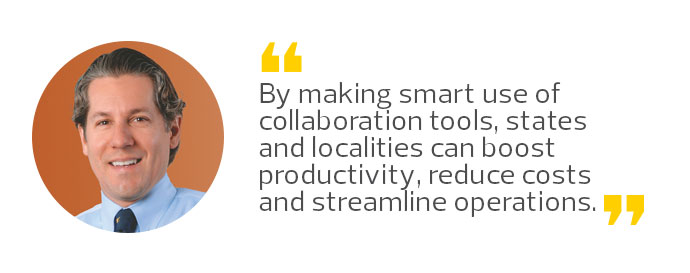Collaboration Drives Teamwork in State and Local Government IT
Be it the state house, a county building, a disaster site or home office, state and local government workers operate in a variety of settings. As organizations incorporate open workspaces, huddle rooms and telework programs, technology can bring staff together like never before.
Collaboration technology binds teams to ensure staffers have the information and resources required to do their jobs more efficiently. A broad array of tools enables the free flow of communication: audio, video, web conferencing and telepresence; instant messaging; social media platforms; document and file sharing; digital displays; interactive whiteboards; and more.
By making smart use of these collaboration tools, states and localities can boost productivity, reduce costs and streamline operations. And most important, governments can better connect with constituents and serve the public more effectively.
Room for Improvement in Collaboration
Despite our heavy reliance on collaboration, though, some professionals find access to these tools is lacking. A 2015 report from Dimensional Research finds that 59 percent of knowledge workers experience challenges with technology. The struggle is greater among millennials, with 71 percent reporting a variety of challenges using the collaboration tools provided to them. This generation prefers to collaborate via chat and text and seeks tools that help them quickly work through problems.
Knowledge workers identified, as the most common collaboration problems they encounter, the use of disparate tools and exclusion of stakeholders; inability to easily measure who is doing what to evaluate individual contribution; outdated documents; and difficulty knowing when a task is complete. These shortcomings can impede productivity and make it difficult to ensure everyone is on the same page.

The good news, however, is that upcoming deployments will help close the gap. IDG’s “2015 Unified Communications and Collaboration (UCC) Survey” predicts a surge of adoption in UCC over the next few years. According to the findings, 56 percent of organizations currently use UCC solutions, and 61 percent plan to implement or upgrade UCC solutions by 2018.
IDC’s “Worldwide Unified Communications and Collaboration Forecast, 2015–2019” also anticipates increased demand for UCC. Rich Costello, senior research analyst for IDC’s Unified Communications and Collaboration, notes that interest in cloud, mobility and collaboration within context is driving continued growth in UCC solutions.
“A better, more intuitive user experience is also a goal of many organizations, as well as integrating/embedding business processes and applications with communications,” he says in the report.
What to Look For in a Collaboration Solution
Available from leading manufacturers such as Avaya, Cisco Systems, Microsoft and Mitel, traditional UCC platforms offer a great way to enhance an organization’s collaborative capabilities. Collaboration alone comprises many technologies, as defined by Gartner:
- telephony
- conferencing
- messaging
- presence and instant messaging (IM)
- clients
- communications-enabled business processes
Agencies should consider cloud UCC solutions for robust security, the ability to meet their requirements, ease of use and low total cost of ownership.
To better manage the free flow of information, investigate file-sharing and online collaboration tools, such as Box, Google Apps for Work and Microsoft Office 365, that can help team members quickly tap into vital knowledge and disseminate it throughout the organization.
To improve the quality of meetings, explore room-based or cloud video conferencing technology and seek out solutions that provide low levels of latency, jitter and packet loss. Finally, be sure to implement collaboration tools that deliver a good mobile experience, including video and full UC functionality across a range of devices.
Deploying a host of modern collaboration tools can help governments serve the public more efficiently and increase engagement with constituents.









